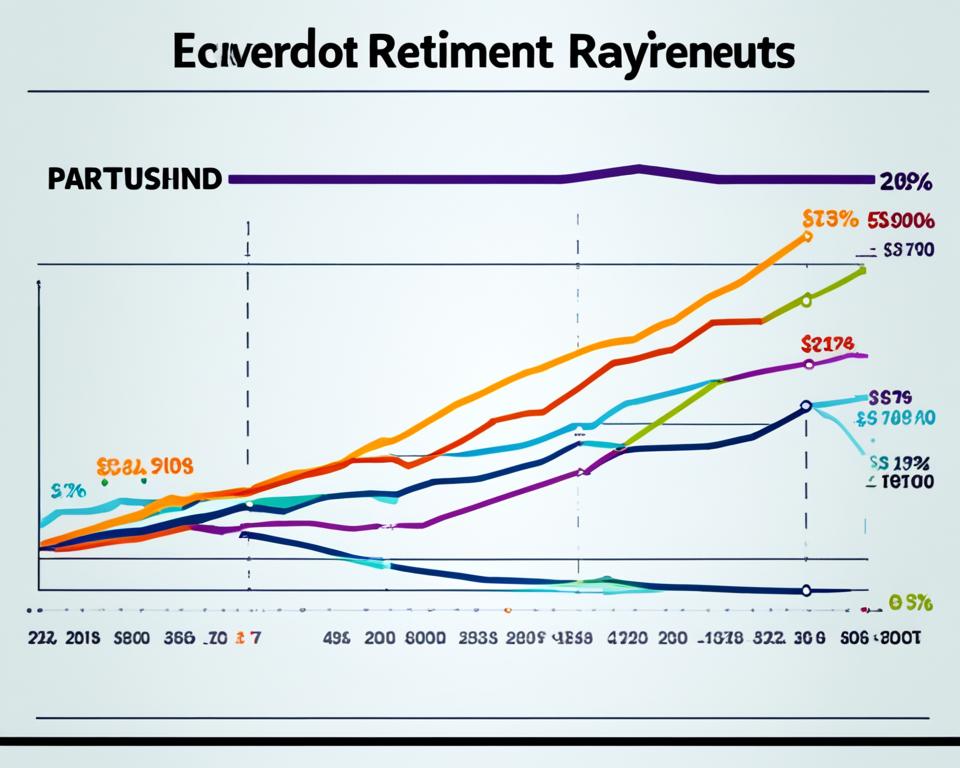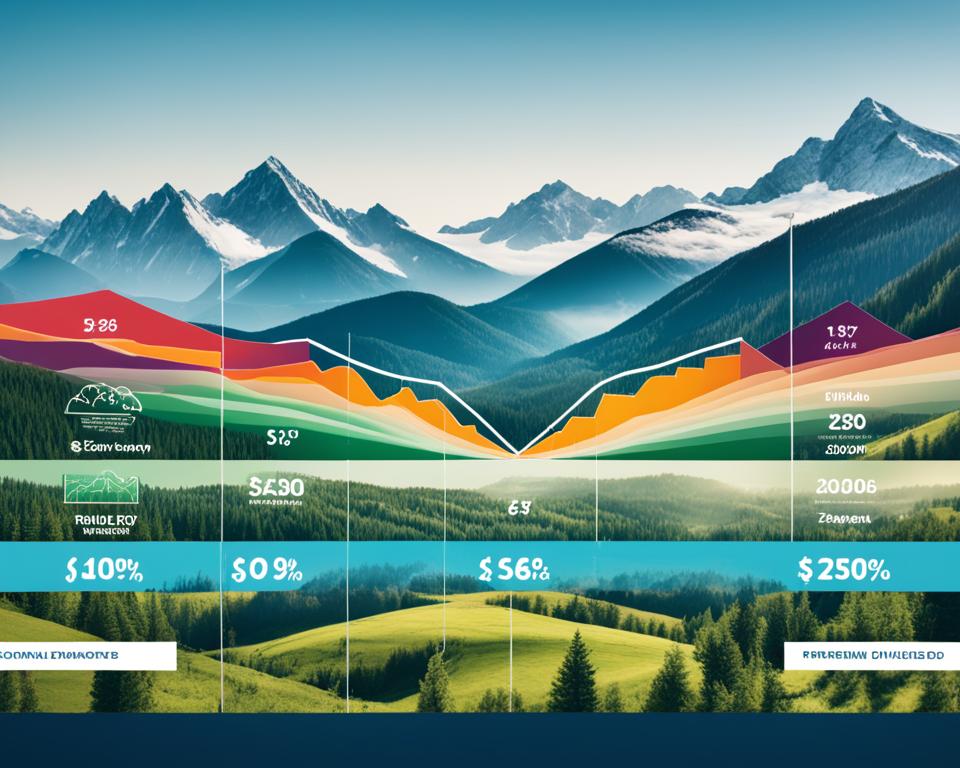When it comes to retirement income planning, one approach stands out for its ability to combine stability with growth: the dividend retirement strategy. If you’re seeking a method to generate passive income for retirees, leaning into the world of dividends within your retirement accounts might be the answer you’ve been searching for. Unlike other strategies that rely on depleting your nest egg, a dividends-focused plan allows your investments to provide you with a steady income stream, which can enhance your financial freedom during the golden years.
Selecting the right blend of dividend-paying stocks and incorporating them into tax-advantaged accounts like Roth IRAs, positions you to enjoy your retirement without the worry of tapping into your principal investment. The distinctive advantage is the ability to watch your portfolio potentially grow tax-free, solidifying your financial footing for years to come. Engage in a dividend retirement strategy and pave the way for a retirement that’s as comfortable as it is secure.
Key Takeaways
- Dive into the benefits of a dividend retirement strategy to establish a consistent income stream in retirement.
- Explore the unique offerings of Roth IRAs, allowing for tax-free growth and distributions, bolstering your passive income.
- Understand how strategic investments in dividend-paying stocks can maintain and potentially grow your retirement savings.
- Discover the importance of wise retirement income planning to ensure long-term financial stability.
- Learn how a dividends-focused approach can be a game-changer, keeping your principal intact while supporting a comfortable lifestyle.
Understanding Dividend Retirement Strategy
Embarking on the journey of dividend investing for retirement can be akin to discovering a path that not only leads you towards financial stability but also paves the way for building wealth in retirement. Dividends, often the profits distributed by companies to shareholders, stand as one of the cornerstones in the creation of a retirement plan that is not only sustainable but also capable of weathering various economic conditions. Let’s delve into understanding dividends and their crucial role in crafting a resilient retirement portfolio.
What Are Dividends and How Do They Work?
Dividends are payments made to shareholders out of a company’s earnings. When you invest in a dividend-paying stock, you are essentially purchasing a share of the company’s profit. These payments are usually made quarterly and can be taken as cash or reinvested to buy more shares. It’s this reinvestment strategy that makes dividend-paying stocks so attractive to those building wealth in retirement—it allows for the snowball effect of compound growth. But how exactly do dividends fit into retirement planning?
The Role of Dividends in Retirement Planning
Your retirement portfolio diversification should aim to strike a balance between income and growth. Here is where dividend investing for retirement shines; it offers a dual advantage. You receive a regular income from the dividends, which can fund your retirement living expenses, and if you choose, you can reinvest dividends to purchase additional shares, propelling your portfolio’s growth over time. This strategic balance can be crucial in extending the longevity of your nest egg.
Comparing Dividend Income to Traditional Retirement Funds
Traditional retirement funds often rely on the liquidation of assets to provide income, which might dwindle your investment over time. Alternatively, a dividend retirement strategy is designed to maintain or even grow your principal investment while also doling out periodic payments. This can be particularly empowering if you’re aiming for a retirement plan that not only sustains but augments your wealth over the years. Each dividend payment reinforces your income stream, adding a layer of financial security in contrast to chipping away at the fund’s core as you might with traditional retirement accounts.
“Embrace a dividend retirement strategy to cultivate a diversified, consistent income stream that not only strives for financial independence but also values growth and sustainability of your retirement assets.”
As you chart your course towards retirement, keep in mind the substantial role that dividends can play in ensuring a comfortable future. There’s an empowering sense of assurance that comes with knowing you have set up a system designed to provide continual financial support throughout your golden years. With a well-constructed dividend retirement strategy, you’re one step closer to a future marked by stability and prosperity.
Setting Up Your Dividend Portfolio for Retirement
As you consider your retirement savings strategies, creating a dividend portfolio emerges as a key approach to securing financial independence in retirement. It’s not only a pursuit for current passive income but also a critical component for future financial resilience. Let’s embark on the strategic process of selecting the right investments and explore diversifying options that contribute to a robust dividend portfolio, designed for the long haul.
Choosing the Right Dividend-Paying Stocks
When shaping your retirement investment options, the focus should be on quality rather than quantity. High-quality dividend-paying stocks are characterized by their long-standing record of consistent and often rising dividend payouts. To ensure your chosen stocks align with your retirement goals, scrutinize each company’s financial health, its current dividend yield, and growth potential. These stocks should serve as the reliable backbone of your retirement investment portfolio, promising a steady stream of income.
An ideal dividend-paying stock is one that has weathered various market cycles, yet has delivered consistent dividends without fail, demonstrating resilience and sound management.
Diversification Through ETFs and Mutual Funds
A robust dividend portfolio must have diversification at its core to mitigate risk and promote sustainability. Employing ETFs and mutual funds focusing on dividends enables you to spread your investment across a gamut of sectors and industries, thus reducing the impact of volatility on a single investment. These dividends-focused collective investment vehicles are a pragmatic choice for investors seeking balanced exposure without the need to research numerous individual stocks.
- ETFs oriented towards dividends can lower overall portfolio risk while providing a balanced yield.
- Mutual funds with a dividend strategy enable access to a pool of dividend growth stocks, curated by professional managers.
To illustrate how these instruments function within a diversified portfolio, let’s consider a comparison of potential ETF and mutual fund investments.
| Investment Vehicle | Yield | Growth Focus | Diversification Level |
|---|---|---|---|
| Dividend ETFs | High | Moderate | High across various sectors |
| Dividend Mutual Funds | Varies with the fund strategy | Varies with the fund objectives | Managed diversification aligned with fund goals |
A comprehensive approach includes a mix of individual dividend-paying stocks, ETFs, and mutual funds to cushion against market disruptions and align with your long-term financial objectives.
Knowing that you have a dividend portfolio in place, fortified with diversified income streams, you have taken a significant step towards achieving financial independence in retirement. It’s a strategy that offers not just a revenue path for today, but a financial framework that supports your future.
Advantages of a Dividend Retirement Strategy
When you dive into retirement income planning, embracing a dividend retirement strategy offers a compelling advantage that stands out for its robustness. With a promising mix of stability and growth, dividend investing for retirement brings to the table benefits that resonate with the goals of retirees. Let’s explore how this strategy provides not just stability, but also the potential for appreciation and enrichment of your retirement portfolio.
Generating a Steady Income Stream
One of the key attributes of dividend investing is its potential to create a steady and predictable stream of income. For those in retirement, the dividends received from investments can form a consistent flow of funds that can be relied upon. This aspect of dividend investing for retirement is particularly vital as it allows you to enjoy financial stability without the need to sell off assets, thereby preserving your investment principal for longer-term appreciation or additional income generation.
Benefit from Potential Stock Appreciation
While the regular dividends contribute to your immediate income needs, the underlying stocks hold the potential for capital appreciation. This dual benefit allows your retirement funds to not only provide regular monetary support but also increases the chances for wealth accumulation through potential stock value growth. Moreover, companies with a strong history of dividend payouts often have a proven track record of stability and resilience, even during economic downturns, making them valuable components of a retirement portfolio.
In summary, a dividend retirement strategy aligns perfectly with comprehensive retirement income planning, offering a methodical approach to generating reliable passive income while also keeping an eye on long-term financial growth and security.
Roth IRA & Dividend Investing: A Tax-Efficient Approach
For those seeking passive income for retirees, combining dividend investing with a Roth Individual Retirement Account (IRA) presents a strategic and tax-efficient avenue. This potent pairing maximizes the tax advantages unique to the Roth IRA format—contributions are after-tax, meaning the dividends and capital gains that accrue are poised to reward you with tax-free income streams under the right conditions.
Understanding the scope of permissible investments within a Roth IRA can help you tailor a portfolio that supports a robust and flexible approach to retirement planning. Pursuing various asset types within these accounts not only fosters diversification but also optimizes your chances of tapping into different growth potentials and income streams.
Kinds of Investments for Roth IRAs
When it comes to your Roth IRA, you’re not confined to one type of investment. A broad array of options allows you to build a diversified portfolio that resonates with your financial objectives and comfort with risk. From sturdy dividend-paying stocks, offering the potential for both income and appreciation, to Exchange-Traded Funds (ETFs) that wrap a multitude of assets into a single tradeable entity—diversifying within your Roth IRA can be a balanced dance between stability and opportunity.
Diving deeper, mutual funds emerge as a compelling choice, pooling resources to invest in a finely curated collection of assets with professional management at the helm. Bonds too find their place, delivering predetermined interest income and a sense of security amidst market ebbs and flows. Other vehicles like Certificates of Deposit (CDs) and even real estate exposure through certain funds are all part of the Roth IRA’s versatile investment repertoire.
Roth IRA Distributions: Tax Benefits Explained
The real allure of the Roth IRA in the realm of retirement planning comes to the fore when we talk about distributions. In this savings structure, if you’re over 59.5 years old and have maintained the account for at least five years, the money you withdraw—including dividends accumulated—incurs no taxes. This unparalleled benefit punctuates the value of the Roth IRA for those who carefully plan their retirement years.
Whether you’re nurturing a nest egg with growth-oriented investments or prefer to sit back and enjoy the returns from your dividend-rich portfolio, understanding these distribution rules can be the difference between a retirement suffused with financial surety and one riddled with avoidable tax burdens.
A retirement strategy that elegantly weaves together the tax-advantaged nature of Roth IRAs with the reliable income generation of dividend investing can indeed serve as a cornerstone for earning passive income for retirees. Grasping the intricacies of this approach can set the foundation for a retirement landscape colored with confidence and ease.
Maximizing Your Retirement Savings: Dividends vs. Bonds
As you forge your path towards financial independence in retirement, recognizing the shifting landscape of investment options can make all the difference. Where once bonds provided the backbone for retirement income, today’s economic climate demands a keen eye towards alternative strategies.
In the realm of retirement portfolio diversification, the age-old debate of dividends versus bonds has taken on new significance. Now, let’s unveil the dynamics of declining bond yields and the promising steadfastness of dividends in ensuring a future-proof nest egg.
The Declining Yield from Treasury Bonds
Gone are the halcyon days when you could rely on Treasury bonds to steadily underpin your retirement funds. The yields on these instruments have experienced a worrying contraction over the years, leading to significant implications for retirees. This downtrend has trimmed down the once reliable source of income, leaving many to reconsider their reliance on these traditional investment vehicles.
Why Dividends May Be a Safer Bet than Bonds for Retirement
Amid this shift, dividend-paying stocks step into the limelight as a more resilient alternative. Unlike bonds, whose fixed-income stream has dwindled, dividend investments have the propensity to increase payouts progressively. This scale-up can serve effectively as an inflation hedge, maintaining—and often enhancing—your purchasing power throughout retirement. Thus, if you’re committed to a strategy that heightens your savings and champions purchasing power, let dividends take the lead in your retirement portfolio diversification.
By choosing dividends over bonds, you’re not just planting seeds for a financially secure retirement—you’re cultivating a robust garden that could flourish in the face of economic change.
Aligning your retirement vision with dividends may elevate your journey toward financial independence, spinning a web of income that not only supports but potentially expands with every passing year.
- Dividends offer potential growth and inflation protection, contributing to a dynamic income source.
- By integrating dividends into your portfolio, you’re invited to a haven of opportunity, geared towards maximizing your financial fortitude as you step into retirement.
Optimizing Dividend Yield in Your Retirement Strategy
When embarking on retirement income planning, an integral part of securing your future is optimizing the dividend yield within your portfolio. This method provides a balanced approach allowing you to increase personal finance acumen while building wealth in retirement. By strategically selecting dividend-paying stocks, you can craft a retirement strategy that boasts a higher yield and sustains your lifestyle without compromising your savings.
To begin this process, it’s crucial to identify stocks that offer higher than average dividends and the promise of continued growth. A focus on companies that have a consistent, long-term history of dividend increases can lead to a steadily rising income over time—key to a prosperous retirement. This isn’t just about immediate gains, but rather fostering an income stream that thrives in the long-term.
“The magic of compounding interest becomes most apparent when reinvesting dividends. It’s where patience meets profit.”
Reinvesting your dividends can significantly enhance the yield on the initial cost of your investments. Consider this: reinvesting dividends from a stock with an annual growth can compound its effect, ultimately magnifying your portfolio’s capacity to provide for you in your golden years. It’s the foresight of reinvestment that could eventually cover a substantial portion of your living expenses in retirement.
- Analyze historical data to identify dividend stocks with consistent growth.
- Utilize dividend reinvestment plans (DRIPs) for compounded growth.
- Regularly monitor and review your portfolio to adjust for optimal yield.
In practice, a disciplined dividend reinvestment strategy can lead to exponential growth in your portfolio’s income potential. Let’s illustrate the significant impact of this approach with a table:
| Year | Initial Investment ($) | Dividend Yield (%) | Reinvested Dividend ($) | Year-End Balance ($) |
|---|---|---|---|---|
| 1 | 10,000 | 4 | 400 | 10,400 |
| 2 | 10,400 | 4.5 | 468 | 10,868 |
| 3 | 10,868 | 5 | 543.4 | 11,411.4 |
| 4 | 11,411.4 | 5.5 | 627.6 | 12,039 |
This table exemplifies how reinvesting dividends back into your portfolio can accelerate the growth of your retirement funds. With each passing year, the yield on the initial investment increases, contributing to a more robust retirement income.
By adopting a strategic focus on high-yielding, growth-oriented dividend stocks, and capitalizing on the power of reinvestment, you’re setting the course for retirement income planning that not only supports your current lifestyle but also bolsters your wealth for years to come. Remember, optimizing dividend yield is less about chasing the highest yield today, but more about nurturing a yield that grows tomorrow.
Comparing Traditional vs. Roth IRAs for Retirement
When you’re weighing your retirement savings strategies, deciding between a Traditional Individual Retirement Account (IRA) and a Roth IRA is pivotal. Both accounts offer distinctive tax advantages that can influence your retirement investment options and ability to save. Here, we explore the intricacies of these retirement vehicles to help you understand and make an informed choice aligned with your financial goals.
Contribution Limits and Procedures for IRAs
Understanding the rules about contributions is essential when gauging IRAs for your retirement. Both Traditional and Roth IRAs impose limits that can affect your annual savings. The IRS sets these contribution limits and they can change year-to-year to adjust for inflation. Your modified adjusted gross income (MAGI) also plays a critical role in determining how much you can contribute. These limits influence the growth of your savings and, by extension, the strength of your retirement nest egg. Staying informed and compliant with these guidelines ensures that you maximize retirement contributions.
| IRA Type | Contribution Limits | Tax Deductibility | Additional Notes |
|---|---|---|---|
| Traditional IRA | Varies based on age and income | Tax-deductible (subject to income levels) | Withdrawals are taxed as income |
| Roth IRA | Varies based on age and income | Not tax-deductible | Qualifying withdrawals are tax-free |
How Dividends are Treated in IRAs
For those using dividend-focused retirement investment options, how dividends are treated in your IRA is crucial. In a Traditional IRA, your investments grow tax-deferred, meaning you won’t pay taxes on dividends until you take distributions. In contrast, a Roth IRA offers tax-free growth, allowing dividends to compound over time without the bite of taxes. This unique advantage of the Roth IRA can be especially powerful for those who believe their tax rate during retirement will be higher or similar to their current rate. Considering the tax treatment of dividends within these accounts highlights the importance of aligning your investment choices with your expected financial situation in retirement.
As you journey towards a future of financial independence, delineating the right type of IRA pivotal. It’s not a decision to take lightly, as the nuances between traditional and Roth IRAs can profoundly affect both your short-term savings and long-term retirement readiness. Your choice should factor in your current income, expected future tax rate, and retirement savings strategies to ensure you’re positioning yourself to make the most of your golden years.
Dividend Stocks: Key to Sustaining a Comfortable Retirement Lifestyle
As the pursuit of a stable financial future intensifies with age, an increasing number of savvy retirees are turning to dividend stocks as a means to enhance their retirement lifestyle. Given their potential for generating passive income for retirees, dividend stocks have become synonymous with a sense of financial security that can last throughout one’s golden years.
Living Off Dividends vs. Selling Assets
The concept of living off dividends involves using the payments received from dividend stocks as a source of steady income, without the need to sell off valuable assets from your portfolio. This approach allows for the principal amount of your investment to remain intact, potentially increasing in value over time. As life expectancies increase and retirees seek to stretch their savings further, having a reliable stream of passive income can be a game-changer in preserving quality of life and maintaining retirement portfolio diversification.
Dividend Reinvestment as a Growth Strategy
Another strategic facet of leveraging dividend stocks is the dividend reinvestment plan. This growth strategy involves reinvesting the dividends you receive, thereby purchasing additional shares of the dividend-paying stock. Over time, this compounding effect can lead to an increase in the total number of shares you own, enhancing the dividend payouts you receive, which in turn can be reinvested. It’s a powerful cycle that can significantly boost your retirement savings and the income you derive from them.
In summary, integrating dividend stocks into your retirement planning brings forth a robust approach to securing a comfortable, financially independent lifestyle in retirement. With careful selection and management, dividends provide a prudent path to enriching your golden years with a sustainable and potentially growing income stream.
Understanding the Risks of Dividend Investing
Embarking on a dividend investing strategy is an appealing route for many seeking financial independence in retirement, but as in all investment approaches, it comes with its own set of risks. While dividends can contribute to a reliable income stream and promote portfolio growth, it’s essential to remain cognizant of the factors that might affect this income. Let’s delve into the critical evaluations needed to keep your retirement plans resilient in the face of adversities such as market volatility.
Assessing Dividend Sustainability
Dividend sustainability occupies a central spot in the investment decision-making process, especially for those targeting a steady stream of income into retirement. A company’s ability to maintain and grow its dividends is anchored in its financial well-being and earning power. Nonetheless, payouts that exceed earnings or free cash flow may signal a red flag, suggesting potential dividend cuts in the future. For this reason, a thorough analysis of a company’s payout ratio, earnings consistency, and dividend coverage is imperative to determine if the dividend is sustainable in the long term.
Market Volatility and Dividend-Paying Stocks
Market fluctuations indeed have the power to shift the landscape for dividend-paying stocks. When market volatility strikes, stock prices can take a hit, affecting the perceived value and overall performance of your portfolio. However, it’s worth noting that companies with a strong track record of dividend consistency and growth often display resilience during volatile market periods. Nonetheless, maintaining a vigilant stance and keeping a diversified investment portfolio can help absorb the shock of market disturbances and sustain your pathway towards financial independence in retirement.
To demonstrate the balance between dividend yield and volatility, consider the following table:
| Stock | Dividend Yield | 5-Year Dividend Growth Rate | 5-Year Average Beta |
|---|---|---|---|
| Company A | 3% | 5% | 0.6 |
| Company B | 4% | 7% | 0.8 |
| Company C | 2.5% | 6% | 0.7 |
The above table showcases a blend of appealing dividend yields alongside promising growth rates and historical market volatility, as indicated by the beta value. The lower the beta, the less correlation to market swings—a crucial factor to consider for those prioritizing stability.
Coming to terms with the intrinsic risks of dividend investing paves the way to a well-informed and balanced retirement strategy. By carefully weighing the potential hazards and reinforcing your portfolio with a variety of dividend-paying stocks, you can strive to achieve a harmonious blend of income and security to support your retirement aspirations.
The Growing Appeal of Dividend-Paying Equities for Retirees
With the uncertainty surrounding Social Security and the meager yields offered by traditional bonds, retirement savings strategies have had to evolve. Now, retirement investment options increasingly spotlight dividend-paying equities—an approach gaining traction among retirees seeking sustainable income streams. These equities not only offer the promise of long-term financial stability but also directly cater to the growing need for passive income for retirees. It’s a strategic pivot aligning with the ever-important goal of generating a dependable income during retirement.
Dividend stocks tend to provide a respite from the unpromising returns of fixed-income securities, particularly when interest rates hover near historic lows. The allure of these stocks isn’t purely for their potential for price appreciation but the ongoing cash flows that can bolster a retiree’s quality of life. As lifespans extend and retirees face the need to stretch their savings further, the ability to tap into a rising stream of dividend payments holds immense value.
Furthermore, adopting dividend stocks as a core component of your retirement portfolio can act as a hedge against inflation—a concern not sufficiently addressed by the fixed income from bonds. As such, individuals looking to refine their retirement income planning may find dividend-paying equities a lucrative frontier, combining growth with income to mitigate the financial pressures of retirement.
Let’s take a closer look at why dividends have captured the confidence of the retirement populace:
- **Predictable Income:** The regular dividend payments from these equities can prove more reliable than bond interest, offering a firmer financial foundation in one’s retirement years.
- **Inflation Resilience:** Dividend payouts often increase over time, providing income that can keep pace with the rising cost of living, unlike the static payouts from bonds.
- **Ownership with Growth Potential:** Holding dividend-paying stocks keeps you invested in the market, leaving room for capital appreciation alongside dividend income.
To illustrate the potential that dividend equities hold in a retiree’s portfolio, consider the following overview:
| Investment Type | Income Potential | Growth Possibility | Inflation Adjustment |
|---|---|---|---|
| Bonds | Stable, but low | Limited | None |
| Dividend Equities | Varies, potential to increase | High | Annual increases possible |
As retirement horizons expand and traditional financial vehicles offer less security, a growing number of individuals are awakening to the benefits of bolstering their portfolios with dividend-bearing stocks. Whether you’re poised to enter retirement or are already navigating its challenges, incorporating dividend equities into your investment strategy may very well be the keystone for a comfortable and prosperous retirement.
Take a decisive step towards securing your livelihood in retirement by weaving dividend-paying equities into your financial tapestry, creating a colorful mosaic of income and growth that resonates with your aspiration for a serene retirement.
Dividend Retirement Strategy: A Path to Financial Independence
As you approach the golden years, a dividend retirement strategy stands out as a beacon on your journey to financial independence in retirement. Emphasizing the value of retirement income planning, this approach underscores the power of dividends to reinforce your retirement fund with regular income flows and opportunities for asset growth. Let’s delve into what makes this strategy a key component for a future of self-reliance and comfort.
Envisioning a retirement that affords you the bliss of freedom and choice begins with crafting a portfolio rich in dividend-paying stocks. With a mindful selection of these assets, you’re not only aiming for yields that meet present financial needs but are also planting seeds for continued prosperity. Dividend stocks can multiply your wealth while safeguarding your principal investment, ensuring that you have ample means to support a lifestyle that you have worked so hard to achieve.
At the heart of this strategy is the conscious pursuit of stocks known for their dividend growth and resilience. You’re looking for companies with an exemplary history of not just rewarding shareholders but also showing the capacity to thrive and adapt through market changes. This resilience translates into a more stable and potentially growing stream of income for you, anchoring your retirement in a way that fixed-income bonds traditionally can’t match.
“It’s not just about finding peace in the present, but nurturing a future that continues to grow.”
It’s important to recognize that success in generating robust dividends often requires regular, vigilant portfolio management. As market conditions fluctuate and business cycles evolve, your dividend-paying assets may need to be reassessed and realigned with your long-term retirement goals. The diligent oversight of your investments is a critical step toward ensuring the longevity of your income stream.
- Opt for companies with a consistent track record of paying and increasing dividends.
- Embrace diversity in your portfolio to mitigate risks and capitalize on various sector strengths.
- Maintain a clear vision of financial goals, aligning your choices with personal retirement timelines and expected income needs.
Let’s draw a practical parallel with a hypothetical comparison of different dividend-paying stocks:
| Stock Category | Yield Profile | Dividend Growth Potential | Resilience During Economic Downturns |
|---|---|---|---|
| Established Blue-Chip Stocks | Moderate to High | Steady | Highly Resilient |
| Emerging Market Stocks | Variable | Uncertain | Less Resilient |
| High-Growth Tech Stocks | Generally Low | Variable | Moderate Resilience |
By situating your retirement plans within the context of a dividend retirement strategy, you’re investing not just in present-day tranquility but also in the enduring stability of your financial future. With this sustained approach, you march towards financial independence in retirement, bolstered by a well-curated assemblage of assets that serve as the bedrock of your livelihood.
Remember, it’s a combination of foresight, discipline, and smart investment choices today that crafts the narrative of your financial independence tomorrow. By embedding a dividend retirement strategy into your blueprint for the future, you seize control over your destiny, unwavering in the face of economic tides.
Conclusion
As you reflect on the journey of retirement income planning, the strategic potential of dividend investing becomes increasingly clear. This path offers not merely a supplement to your retirement fund but stands as a cornerstone for securing your financial future. By weaving a dividend retirement strategy into your financial blueprint, you can cultivate a resilient income stream that supports both today’s needs and tomorrow’s dreams.
Evaluating the Impact of Dividend Investing on Retirement Planning
The allure of dividends for retirement lies in their unique blend of reliability and growth potential. When you infuse your retirement planning with dividend-paying stocks, you’re not just bolstering your income for the immediate future—you’re strengthening the fabric of your long-term financial stability. With smart choices that favor dividends, especially within Roth IRAs, you can shield your gains from taxes, thereby enriching the reserves from which your retirement security will flow.
Key Takeaways for Retirees who Wish to Secure Their Financial Future
Your commitment to prudent financial stewardship is affirmed by considering dividends as part of your retirement strategy. Through dividends, you ensure a steady influx of resources that can adjust with living costs, fortifying your lifestyle against the unpredictable. This approach should be a guiding force in your retirement income planning, empowering you to achieve the independence you’ve envisioned for your golden years. Securing your financial future requires diligence and foresight—qualities that are well rewarded in the realm of dividend investing. Remember, your peaceful retirement isn’t just a hope—it’s a plan that you can establish and expand through the strategic application of dividends.
FAQ
What Are Dividends and How Do They Work?
Dividends are payments made by a corporation to its shareholders from its profits or reserves. When you own dividend-paying stocks, you are entitled to receive a share of the company’s earnings periodically. These payouts can be distributed monthly, quarterly, semi-annually, or annually and can be in the form of cash or additional stock.
How Do Dividends Contribute to Retirement Planning?
In retirement planning, dividends serve as a source of regular income that can supplement other retirement benefits such as Social Security or pensions. A dividend retirement strategy involves investing in stocks that pay reliable dividends, which provides retirees with an ongoing income stream without necessitating the sale of shares, aiding in the preservation of investment principal.
How Does Dividend Income Compare to Traditional Retirement Funds?
Traditional retirement funds often require selling assets to generate income, which can deplete the retirement portfolio over time. In contrast, a dividend retirement strategy focuses on income from dividends, thus preserving the underlying investment while providing cash flow. This can help maintain your portfolio’s value and potentially even grow it over time with the power of reinvested dividends.
What Should I Consider When Selecting Dividend-Paying Stocks for Retirement?
When choosing dividend-paying stocks for your retirement, consider the company’s financial health, the stability and history of its dividend payouts, the dividend yield, and potential for dividend growth. It’s also essential to be aware of the sector and industry of the company to ensure your portfolio is diversified and not overly reliant on any single type of business.
Why is Diversification Through ETFs and Mutual Funds Important for Retirees?
Diversification helps to spread risk and reduce the volatility of your retirement portfolio. Investing in ETFs (Exchange-Traded Funds) and mutual funds that focus on dividend-paying stocks allows you to gain exposure to a broad range of sectors and companies with just a single investment, providing a safeguard against the downturn of any particular stock or sector.
What Are the Advantages of a Dividend Retirement Strategy?
A dividend retirement strategy provides a steady income stream from the dividends paid out, which can offer financial stability in retirement. Additionally, there is potential for capital appreciation of the stock itself, and dividends can also contribute to a portfolio’s resilience during market downturns.
How Are Investments in a Roth IRA Tax-Efficient for Retirees?
Investments in a Roth IRA are made with after-tax money, and the qualifying withdrawals, which include the earnings from dividends, are generally tax-free. This allows the investment gains, including compounded dividends, to grow and be withdrawn without additional tax liability, providing a tax-effective income stream in retirement.
Why Might Dividends Be a Better Option than Bonds for Retirement Income?
With historically low yields from safer investments like Treasury bonds, dividend-paying stocks might offer higher income yield and can also provide the potential for dividend growth over time. This growth can act as a hedge against inflation and help sustain purchasing power during retirement.
Can You Explain the Contribution Limits and Procedures for IRAs?
Both Traditional and Roth IRAs have annual contribution limits, which may change over time and can be affected by your income level. Contributions to Traditional IRAs may be tax-deductible, depending on your income and other factors, while Roth IRA contributions are not tax-deductible. It’s important to stay updated on the current year’s IRA contribution limits and eligibility requirements to maximize your retirement savings.
How Are Dividends Treated in IRAs?
Dividends earned within IRAs are not taxable events when they are distributed. In Traditional IRAs, dividends and other investment earnings are tax-deferred, meaning you’ll pay taxes upon withdrawal. In Roth IRAs, dividends grow tax-free, and qualified withdrawals of these earnings are also tax-free.
What is the Benefit of Living Off Dividends versus Selling Assets in Retirement?
Living off dividends provides a retirement income without having to sell your investment assets, which allows your portfolio to potentially grow over time. This method aims to protect the principal of your investments and offers the advantage of continued exposure to the potential for capital appreciation in the stock market.
How Can Dividend Reinvestment Contribute to Retirement Growth Strategies?
Dividend reinvestment is a strategy where the dividends received are used to purchase more shares of the dividend-paying stock or fund, which can compound growth over time. This can lead to owning a larger number of shares and potentially receiving even larger dividends in the future, helping to ensure that income keeps pace with inflation and expands your asset base in retirement.
What Should I Know About the Risks of Dividend Investing?
While dividend investing can offer a steady income, there are risks including dividend cuts or suspensions if a company faces financial difficulties. Market volatility can also affect the stock prices of dividend-paying companies. It’s essential to assess the sustainability of a company’s dividend and diversify your investments to mitigate these risks.
Are Dividend-Paying Equities Becoming More Popular with Retirees?
Yes, with the low interest rate environment making traditional fixed-income investments less attractive, many retirees are turning to dividend-paying equities for their potential to provide a higher income yield and the possibility for dividend growth. This makes them a compelling consideration for those seeking to enhance their retirement income.
How Does a Dividend Retirement Strategy Facilitate Financial Independence in Retirement?
A dividend retirement strategy aims to generate a steady, reliable income stream that can cover living expenses, thereby reducing the need to draw down the principal of retirement savings. This approach can help retirees maintain financial independence by providing consistent payouts and the prospect of a self-sustaining income throughout retirement.












